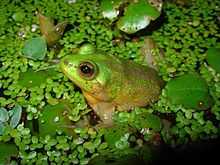Pseudis paradoxa
| Pseudis paradoxa | |
|---|---|
 | |
| Conservation status | |
| Scientific classification | |
| Kingdom: | Animalia |
| Phylum: | Chordata |
| Class: | Amphibia |
| Order: | Anura |
| Family: | Hylidae |
| Genus: | Pseudis |
| Species: | P. paradoxa |
| Binomial name | |
| Pseudis paradoxa (Linnaeus, 1758) | |
Pseudis paradoxa, known as the paradoxical frog or shrinking frog, is a species of hylid frog from South America.[2] Its name refers to the very large—up to 25-cm-long—tadpole (typical of the Pseudis genus), which in turn becomes an ordinary-sized frog, only about a quarter of its former length.[3]
Pseudis paradoxa is green coloured with dark green or olive stripes. It inhabits ponds, lakes and lagoons from northern Argentina, through the Pantanal, Amazon and the Guianas, to Venezuela and Trinidad, with a disjunct distribution in the Magdalena River watershed in Colombia and adjacent far western Venezuela. The female frog lays eggs among water plants; the eggs develop into giant tadpoles.
These amphibians feed on larvae, small insects, and tiny invertebrates. The frog is a nocturnal animal and spends most of its life in water. When threatened, the frog uses its strong toes with an extra joint to stir up the muddy bottom and hide. The frog also uses this mechanism to find food on the bottom of lakes and ponds.
In March 2008, scientists working from the Universities of Ulster and United Arab Emirates released findings of a study where the synthesised version of the skin compound pseudin-2 was able to stimulate the secretion of insulin in pancreatic cells under laboratory conditions without toxicity to the cells.[4] This synthetic medicine would be used in the treatment of Type 2 diabetes. Pseudin compounds are thought to have some antimicrobial functions in the paradoxical frog.
In the media
In his book Three Singles to Adventure, Gerald Durrell mentions collecting the tadpoles of the paradoxical frog.
The British quiz show QI, hosted by Stephen Fry, claimed this frog was the only animal to have babies larger than the parent. Apart from the fact that no species could survive such an energy debt in reproducing, in a number of species, the young grow to be larger, or to have more body mass, in adolescence than in maturity, including species with a chrysalis form and oceanic species which cease to be mobile, with the newly sessile form absorbing various body parts from its previous incarnation.
References
- ↑ Ariadne Angulo, Diego Baldo (2010). "Pseudis paradoxa". IUCN Red List of Threatened Species. Version 2011.2. International Union for Conservation of Nature. Retrieved 9 April 2012.
- ↑ Frost, Darrel R. (2013). "Pseudis paradoxa (Linnaeus, 1758)". Amphibian Species of the World 5.6, an Online Reference. American Museum of Natural History. Retrieved 24 October 2013.
- ↑ Emerson, S. B. (1988). "The giant tadpole of Pseudis paradoxa". Biological Journal of the Linnean Society 34 (2): 93–104. doi:10.1111/j.1095-8312.1988.tb01951.x.
- ↑ "Health | Frog skin diabetes treatment hope". BBC News. 2008-03-03. Retrieved 2013-10-09.
See also
| Wikimedia Commons has media related to Pseudis paradoxa. |
